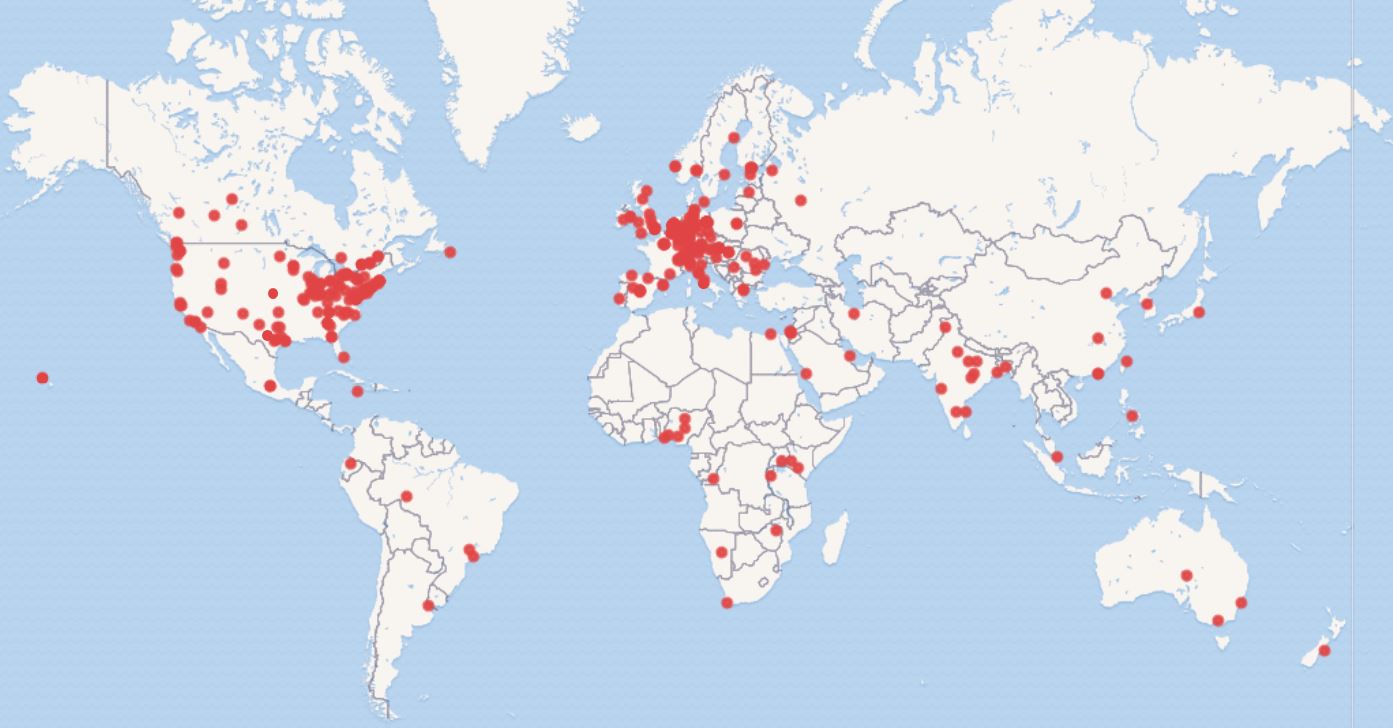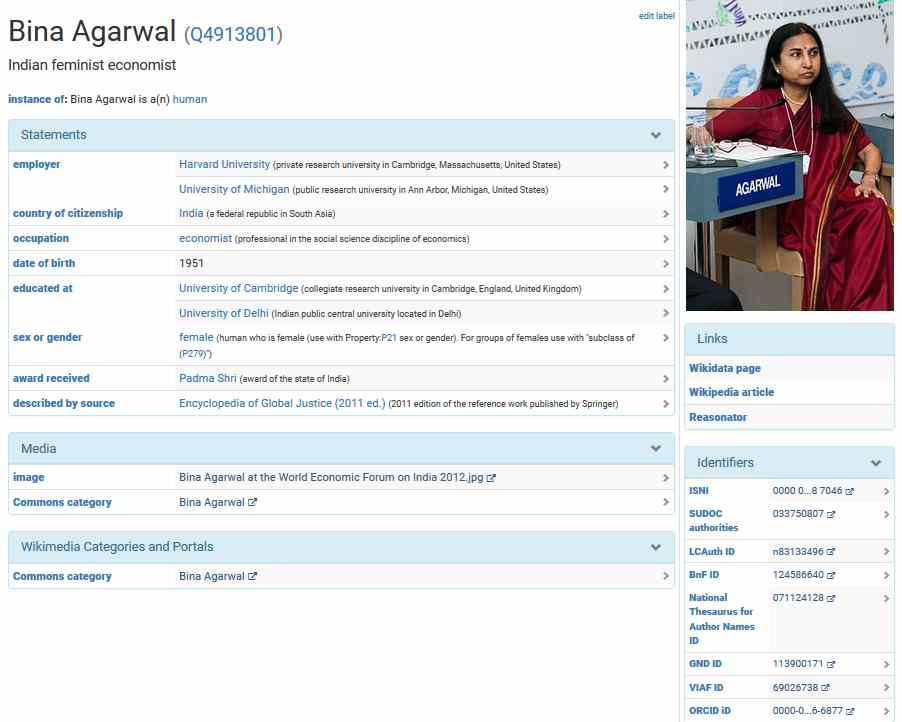Building the SWIB20 participants map
2020-12-07 by Joachim Neubert

Here we describe the process of building the interactive SWIB20 participants map, created by a query to Wikidata. The map was intended to support participants of SWIB20 to make contacts in the virtual conference space. However, in compliance with GDPR we want to avoid publishing personal details. So we choose to publish a map of institutions, to which the participants are affiliated. (Obvious downside: the 9 un-affiliated participants could not be represented on the map).
We suppose that the method can be applied to other conferences and other use cases - e.g., the downloaders of scientific software or the institutions subscribed to an academic journal. Therefore, we describe the process in some detail.
- Read more about Building the SWIB20 participants map
- Log in or register to post comments
20th Century Press Archives: Data donation to Wikidata
2019-10-24 by Joachim Neubert
ZBW is donating a large open dataset from the 20th Century Press Archives to Wikidata, in order to make it better accessible to various scientific disciplines such as contemporary, economic and business history, media and information science, to journalists, teachers, students, and the general public.
The 20th Century Press Archives (PM20) is a large public newspaper clippings archive, extracted from more than 1500 different sources published in Germany and all over the world, covering roughly a full century (1908-2005). The clippings are organized in thematic folders about persons, companies and institutions, general subjects, and wares. During a project originally funded by the German Research Foundation (DFG), the material up to 1960 has been digitized. 25,000 folders with more than two million pages up to 1949 are freely accessible online. The fine-grained thematic access and the public nature of the archives makes it to our best knowledge unique across the world (more information on Wikipedia) and an essential research data fund for some of the disciplines mentioned above.
The data donation does not only mean that ZBW has assigned a CC0 license to all PM20 metadata, which makes it compatible with Wikidata. (Due to intellectual property rights, only the metadata can be licensed by ZBW - all legal rights on the press articles themselves remain with their original creators.) The donation also includes investing a substantial amount of working time (during, as planned, two years) devoted to the integration of this data into Wikidata. Here we want to share our experiences regarding the integration of the persons archive metadata.
- Read more about 20th Century Press Archives: Data donation to Wikidata
- Log in or register to post comments
ZBW's contribution to "Coding da Vinci": Dossiers about persons and companies from 20th Century Press Archives
2018-10-23 by Joachim Neubert
At 27th and 28th of October, the Kick-off for the "Kultur-Hackathon" Coding da Vinci is held in Mainz, Germany, organized this time by GLAM institutions from the Rhein-Main area: "For five weeks, devoted fans of culture and hacking alike will prototype, code and design to make open cultural data come alive." New software applications are enabled by free and open data.
For the first time, ZBW is among the data providers. It contributes the person and company dossiers of the 20th Century Press Archive. For about a hundred years, the predecessor organizations of ZBW in Kiel and Hamburg had collected press clippings, business reports and other material about a wide range of political, economic and social topics, about persons, organizations, wares, events and general subjects. During a project funded by the German Research Organization (DFG), the documents published up to 1948 (about 5,7 million pages) had been digitized and are made publicly accessible with according metadata, until recently solely in the "Pressemappe 20. Jahrhundert" (PM20) web application. Additionally, the dossiers - for example about Mahatma Gandhi or the Hamburg-Bremer Afrika Linie - can be loaded into a web viewer.
As a first step to open up this unique source of data for various communities, ZBW has decided to put the complete PM20 metadata* under a CC-Zero license, which allows free reuse in all contexts. For our Coding da Vinci contribution, we have prepared all person and company dossiers which already contain documents. The dossiers are interlinked among each other. Controlled vocabularies (for, e.g., "country", or "field of activity") provide multi-dimensional access to the data. Most of the persons and a good share of organizations were linked to GND identifiers. As a starter, we had mapped dossiers to Wikidata according to existing GND IDs. That allows to run queries for PM20 dossiers completely on Wikidata, making use of all the good stuff there. An example query shows the birth places of PM20 economists on a map, enriched with images from Wikimedia commons. The initial mapping was much extended by fantastic semi-automatic and manual mapping efforts by the Wikidata community. So currently more than 80 % of the dossiers about - often rather prominent - PM20 persons are linked not only to Wikidata, but also connected to Wikipedia pages. That offers great opportunities for mash-ups to further data sources, and we are looking forward to what the "Coding da Vinci" crowd may make out of these opportunities.
Technically, the data has been converted from an internal intermediate format to still quite experimental RDF and loaded into a SPARQL endpoint. There it was enriched with data from Wikidata and extracted with a construct query. We have decided to transform it to JSON-LD for publication (following practices recommended by our hbz colleagues). So developers can use the data as "plain old JSON", with the plethora of web tools available for this, while linked data enthusiasts can utilize sophisticated Semantic Web tools by applying the provided JSON-LD context. In order to make the dataset discoverable and reusable for future research, we published it persistently at zenodo.org. With it, we provide examples and data documentation. A GitHub repository gives you additional code examples and a way to address issues and suggestions.
* For the scanned documents, the legal regulations apply - ZBW cannot assign licenses here.
New version of multi-lingual JEL classification published in LOD
2017-03-02 by Joachim Neubert
The Journal of Economic Literature Classification Scheme (JEL) was created and is maintained by the American Economic Association. The AEA provides this widely used resource freely for scholarly purposes. Thanks to André Davids (KU Leuven), who has translated the originally English-only labels of the classification to French, Spanish and German, we provide a multi-lingual version of JEL. It's lastest version (as of 2017-01) is published in the formats RDFa and RDF download files. These formats and translations are provided "as is" and are not authorized by AEA. In order to make changes in JEL tracable more easily, we have created lists of inserted and removed JEL classes in the context of the skos-history project.
Economists in Wikidata: Opportunities of Authority Linking
2017-01-17 by Joachim Neubert
Wikidata is a large database, which connects all of the roughly 300 Wikipedia projects. Besides interlinking all Wikipedia pages in different languages about a specific item – e.g., a person -, it also connects to more than 1000 different sources of authority information.
The linking is achieved by a „authority control“ class of Wikidata properties. The values of these properties are identifiers, which unambiguously identify the wikidata item in external, web-accessible databases. The property definitions includes an URI pattern (called „formatter URL“). When the identifier value is inserted into the URI pattern, the resulting URI can be used to look up the authoritiy entry. The resulting URI may point to a Linked Data resource - as it is the case with the GND ID property. This, on the one hand, provides a light-weight and robust mechanism to create links in the web of data. On the other hand, these links can be exploited by every application which is driven by one of the authorities to provide additional data: Links to Wikipedia pages in multiple languages, images, life data, nationality and affiliations of the according persons, and much more.

Wikidata item for the Indian Economist Bina Agarwal, visualized via the SQID browser
- Read more about Economists in Wikidata: Opportunities of Authority Linking
- Log in or register to post comments
Wikidata for Authorities

This project explores the opportunities, which Wikidata provides for libraries (specifically in economics). By linking their authority files to Wikidata, they can earn a wealth of data as well as links to Wikipedia pages, images and links to other authorities.
Update: Neuer dump des EconStor LOD-Datensets steht zur Verfügung
2016-05-17 by Timo Borst
Turning the GND subject headings into a SKOS thesaurus: an experiment
2016-03-30 by Joachim Neubert
The "Integrated Authority File" (Gemeinsame Normdatei, GND) of the German National Library (DNB), the library networks of the German-speaking countries and many other institutions, is a widely recognized and used authority resource. The authority file comprises persons, institutions, locations and other entity types, in particular subject headings. With more than 134,000 concepts, organized in almost 500 subject categories, the subjects part - the former "Schlagwortnormdatei" (SWD) - is huge. That would make it a nice resource to stress-test SKOS tools - when it would be available in SKOS. A seminar at the DNB on requirements for thesauri on the Semantic Web (slides, in German) provided another reason for the experiment described below.
GND subject headings as SKOS thesaurus
The transformation of the subject headings and subject categories of the German Integrated Authority File (GND) to SKOS creates a large and interlinked knowledge organization system. Generic SKOS tools, such as Skosmos, qSKOS and skos-history can be applied to this system.
skos-history: New method for change tracking applied to STW Thesaurus for Economics
2015-07-27 by Joachim Neubert
“What’s new?” and “What has changed?” are questions users of Knowledge Organization Systems (KOS), such as thesauri or classifications, ask when a new version is published. Much more so, when a thesaurus existing since the 1990s has been completely revised, subject area for subject area. After four intermediately published versions in as many consecutive years, ZBW's STW Thesaurus for Economics has been re-launched recently in version 9.0. In total, 777 descriptors have been added; 1,052 (of about 6,000) have been deprecated and in their vast majority merged into others. More subtle changes include modified preferred labels, or merges and splits of existing concepts.
Since STW has been published on the web in 2009, we went to great lengths to make change traceable: No concept and no web page has been deleted, everything from prior versions is still available. Following a presentation at DC-2013 in Lisbon, I've started the skos-history project, which aims to exploit published SKOS files of different versions for change tracking. A first beta implementation of Linked-Data-based change reports went live with STW 8.14, making use of SPARQL "live queries" (as described in a prior post). With the publication of STW 9.0, full reports of the changes are available. How do they work?

